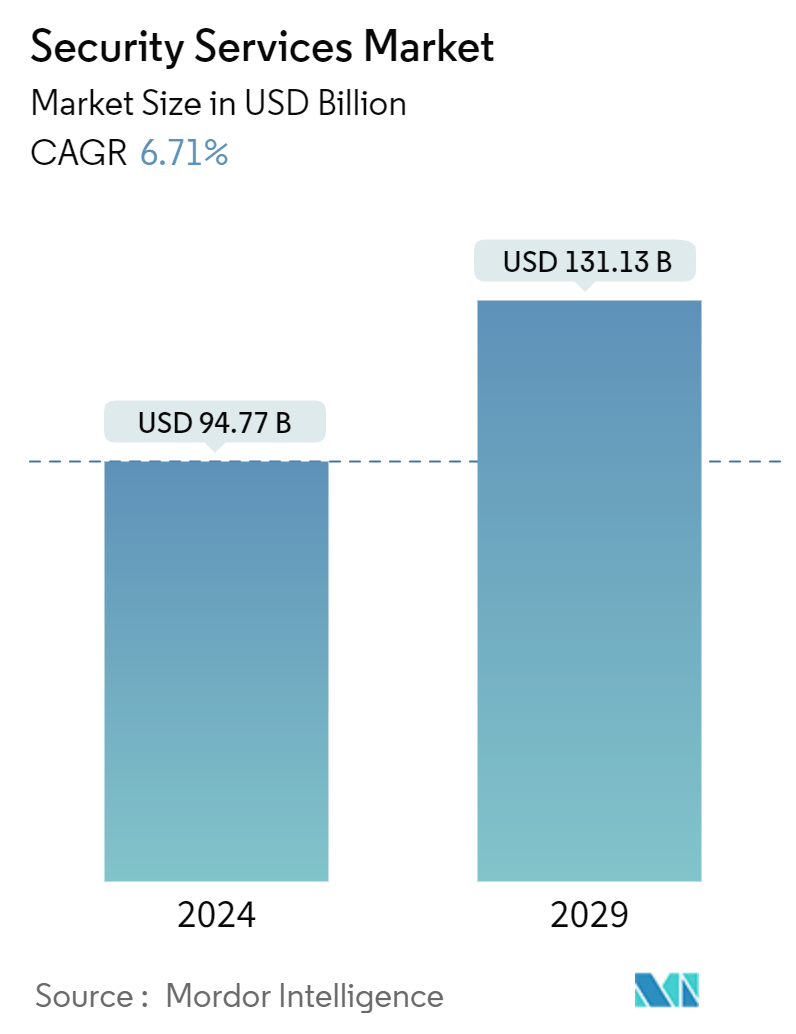| Study Period | 2019 - 2029 |
| Market Size (2024) | USD 94.77 Billion |
| Market Size (2029) | USD 131.13 Billion |
| CAGR (2024 - 2029) | 6.71 % |
| Fastest Growing Market | North America |
| Largest Market | Asia Pacific |
| Market Concentration | Low |
Major Players*Disclaimer: Major Players sorted in no particular order |
Security Services Market Analysis
The Security Services Market size is estimated at USD 94.77 billion in 2024, and is expected to reach USD 131.13 billion by 2029, growing at a CAGR of 6.71% during the forecast period (2024-2029).
- The relationship between the physical and digital realms is becoming increasingly complex, necessitating the development of advanced security systems, particularly in more developed economies. The need for security services is rapidly growing as these systems integrate with technologies such as big data and artificial intelligence (AI) through smart devices and the IoT. The emergence of virtual working environments and the ever-evolving demands for facility utilization are leading to new security services and solutions. Additionally, the growth of e-commerce has further increased the demand for technology-enabled security solutions in distribution centers and similar structures.
- The rate of urbanization and industrialization is accelerating as more and more people relocate to cities. The world's urban population is increasing by an average of 1.5 million individuals each week, and this high population density could raise concerns about criminal activity. It is anticipated that the security services market will experience rapid expansion in the majority of developed countries as the utilization of technological monitoring equipment increases. The ongoing industrialization and growth of global industrial production necessitates the investment of production facilities, offices, and other work environments, each with its own security requirements.
- As the global population increases its disposable income, the requirement for security services is likely to grow. For instance, infrastructure investments in public transport and public logistics facilities require the protection of these properties, thus necessitating an increase in the demand for security. Economic growth and ongoing global investment in new construction are both contributing to the development of the security services market. For instance, in July 2023, the Smart Cities mission seeks to address India's rapidly expanding urban population by investing billions in 100 cities nationwide.
- The ever-changing nature of cyber threats necessitates that security services must be constantly adapted. As new attack vectors emerge, organizations can be put at risk if security services are inadequate, thus impeding market development. For instance, in 2023, the three industries that experienced the highest number of data breaches were the healthcare, financial services, and manufacturing sectors.
- Further, one of the major restraints in the security services market is the challenge posed by complexity and integration. Security systems are becoming complex due to the integration of technologies like surveillance cameras, access control, intrusion detection, and cutting-edge analytics driven by AI and ML. While these advancements bolster security, they simultaneously complicate the security landscape, particularly for smaller enterprises, hindering widespread adoption.
Security Services Industry Segmentation
Security services are processes or comprehensive services that improve an organization's protection and security against common cyberattacks, including phishing, malicious software, and ransomware. These services encompass design and integration, deployment, risk and threat analysis, and consultation. Managed and hosted security services and solutions can be supplemented using cloud services, artificial intelligence (AI), biometrics, Internet of Things (IoT), and other remote services.
The security services market is segmented by service type (managed security services, professional security services, consulting services, and threat intelligence security services), mode of deployment (on-premise and cloud), end-user industry (IT and infrastructure, government, industrial, healthcare, transportation, and logistics, banking, and other end-user industries), and geography (North America [United States and Canada], Europe [Germany, United Kingdom, France, and Rest of Europe], Asia-Pacific [India, China, Japan, and Rest of Asia-Pacific], Latin America, and Middle East and Africa). The market sizes and forecasts are provided in terms of value (USD) for all the above segments. The report also covers the overall impact of COVID-19 aftereffects and other macroeconomic trends on the market.
| Managed Security Services |
| Professional Security Services |
| Consulting Services |
| Threat Intelligence Security Services |
| On-premise |
| Cloud |
| IT and Infrastructure |
| Government |
| Industrial |
| Healthcare |
| Transportation and Logistics |
| Banking |
| Other End-user Industries |
| North America | United States |
| Canada | |
| Europe | Germany |
| United Kingdom | |
| France | |
| Asia | India |
| China | |
| Japan | |
| Australia and New Zealand | |
| Latin America | |
| Middle East and Africa |
Security Services Market Size Summary
The security services market is poised for significant growth, driven by the increasing complexity of the relationship between physical and digital realms. As developed economies advance, the integration of technologies such as big data, artificial intelligence, and the Internet of Things into security systems is becoming essential. This integration is further fueled by the rise of virtual working environments and the growing demands of e-commerce, which necessitate technology-enabled security solutions. The rapid urbanization and industrialization trends, coupled with the need for enhanced security in densely populated areas, are expected to propel the market forward. Additionally, the expansion of global infrastructure and the increase in disposable income are contributing to the heightened demand for security services, particularly in public transport and logistics facilities.
The market landscape is characterized by a competitive and fragmented environment, with numerous small and large players vying for market share. Major companies are focusing on expanding their consumer base through partnerships, collaborations, and acquisitions, while also investing in innovative product offerings to maintain a competitive edge. The adoption of cloud-based managed security services is on the rise, driven by the need for adaptability and scalability in response to evolving cyber threats. The Asia-Pacific region, in particular, is witnessing a surge in demand for cybersecurity services due to increased digitalization and geopolitical tensions. As businesses prioritize digital transformation, the need for sophisticated security services to protect digital assets is becoming increasingly critical, further fueling market growth.
Security Services Market Size - Table of Contents
1. MARKET DYNAMICS
-
1.1 Market Drivers
- 1.1.1 Rising Digital Disruption and Increased Compliance Demands
- 1.1.2 Increasing Adoption of Multi-cloud or Hybrid Cloud Strategies
- 1.1.3 Governments Focus on CyberSecurity
-
1.2 Market Challenges
- 1.2.1 Lack of Awareness of Security Services
- 1.2.2 Limited Budget Constraints by Organizations for Security Services
- 1.2.3 Complexity and Integration Challenges
2. MARKET SEGMENTATION
-
2.1 By Service Type
- 2.1.1 Managed Security Services
- 2.1.2 Professional Security Services
- 2.1.3 Consulting Services
- 2.1.4 Threat Intelligence Security Services
-
2.2 By Mode of Deployment
- 2.2.1 On-premise
- 2.2.2 Cloud
-
2.3 By End-user Industry
- 2.3.1 IT and Infrastructure
- 2.3.2 Government
- 2.3.3 Industrial
- 2.3.4 Healthcare
- 2.3.5 Transportation and Logistics
- 2.3.6 Banking
- 2.3.7 Other End-user Industries
-
2.4 By Geography***
- 2.4.1 North America
- 2.4.1.1 United States
- 2.4.1.2 Canada
- 2.4.2 Europe
- 2.4.2.1 Germany
- 2.4.2.2 United Kingdom
- 2.4.2.3 France
- 2.4.3 Asia
- 2.4.3.1 India
- 2.4.3.2 China
- 2.4.3.3 Japan
- 2.4.4 Australia and New Zealand
- 2.4.5 Latin America
- 2.4.6 Middle East and Africa
Security Services Market Research FAQs
How big is the Security Services Market?
The Security Services Market size is expected to reach USD 101.13 billion in 2025 and grow at a CAGR of 6.71% to reach USD 139.93 billion by 2030.
What is the current Security Services Market size?
In 2025, the Security Services Market size is expected to reach USD 101.13 billion.




